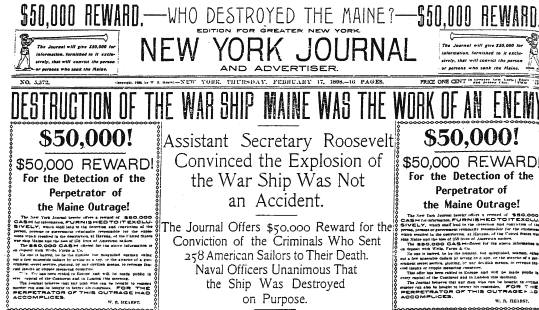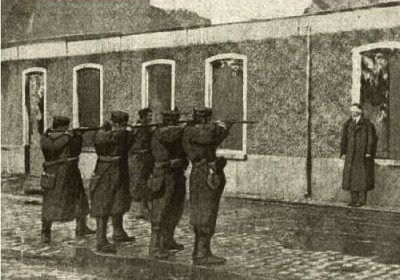Yellow Journalism - Present and Past
Kathryn Mott, February 13 2013
 William Randolph Hearst's New York Journal epitomized the term "yellow journalism" in the 1800s.
William Randolph Hearst's New York Journal epitomized the term "yellow journalism" in the 1800s.Journalism should be about getting the truth out. Usually the truth that a journalist is trying to uncover is something someone else has been trying to hide. In some cases, certain journalists might stretch the truth or even fabricate an entire story. This is when we are left with yellow journalism. Whatever the reasoning behind some journalist's actions, we have to be wary with every story we read.
What is Yellow Journalism?
Yellow journalism can be portrayed in a few different ways. It can be a very biased story that only covers one side without pointing out pertinent and even detrimental facts. It can also be a story that has been published strictly for the "shock factor" and have no basis behind it. When the truth isn't there and the facts are missing or twisted, this is when you have yellow journalism.
Today's fast paced world revolves around technology. It's everywhere; in our cars, phones, watches, even mirrors. Everywhere we go we expect to have access to the Internet. We want to check our emails, our friend's Facebook status and we want to know today's news yesterday.
It could be because of our need for instant gratification that journalists may justify "tweaking" their story a bit, making sure that they get it out first. Whatever their reasoning, the internet makes yellow journalism even easier. You can post anything you want without checking facts.
Yellow Journalism Today
There are many examples of yellow journalism in the news today. A recent story that was circulating on all the top news channels and websites was about a court case between Samsung and Apple. The day after the judge ruled in favor of Apple, a story was published on a website in Mexico that claimed Samsung paid their $1.2 billion dollar fine in nickels. An American journalist picked up the story and ran with it.
The story was complete with quotes and numbers. But, if you do the math, the numbers are completely wrong. They stated that 30 trucks showed up at Apple headquarters with all the money in nickels. It would actually take well over 2,500 trucks and all the nickels that have been struck by the U.S. Mint over the last several decades to pay the $1.2 billion dollars in full.
The website in Mexico where this story originated from was actually all about satire and comedy. They posted false stories, like this one, just as a source of comedic relief. If the person who picked this story up had actually been checking the website and not just focusing on the article, this whole mess wouldn't have happened.
Yellow Journalism in Technology
Picture this, you sit down at your laptop in the morning and you check the news. A large headline catches your attention, "Baby Snatched by Eagle". You immediately click the link to the story and there's a video. You watch the video that, sure enough, shows an eagle swooping down. It grabs a baby and tries to take off again. The baby proves too awkward for the eagle and it drops him not a long distance, but enough to make it news worthy (the "baby" was fine). What a great story, right? The journalist did their job. They found a jaw dropping story that was sure to bring in readers and they even had a video to boot.
Unfortunately, even videos aren't safe from yellow journalism. Shortly after the news story had aired, proof came out that the video was a fake. With today's technology one can create digital effects for just about anything. It turns out that the video had been created by three college students in Canada.
Yellow Journalism in the Past
Even though the internet is considered to be fairly new technology and has become a breeding ground for yellow journalism, it actually started long before the World Wide Web came about. The perfect example of this is a picture that has been circulating around text books, newspapers and even ads since WWI.

The photograph shows a man standing in front of a brick wall blindfolded and facing a firing squad. The picture was first published in a newspaper during WWI. The caption stated that the man was a captured enemy spy. The real story behind the picture is that the photo was staged. There was a photographer who was overseas in Belgium photographing the war. He had taken many staged shots, this being one of them. Not only was this photo staged, but the photographer was actually posing as the "enemy spy".
The photo is now famous and is used frequently but has been mistakenly documented as being from WWII, or used in a way as to imply that the execution depicted actually took place. It rarely has the true story behind it.
The Original Yellow Journalism -- Hearst vs. Pulitzer
The original use of the term "yellow journalism" came from the vicious circulation wars that the New York papers engaged themselves in during the late 1800s. In 1883, Joseph Pulitzer moved to New York and purchased the New York World after a successful stint in St. Louis. By utilizing flashy headlines and lurid subject matter in his articles, Pultizer turned the fortunes of the paper around completely. His success inspired a large number of imitators.
Pulitzer's most successful rival would be William Randolph Hearst, who purchased the New York Journal and lowered the price to a penny. Through the 1890s the two papers tried to outcompete each other on sensationalizing the news -- and often concocting it altogether. Hearst was the worst offender, and his stories about the ongoing conflict in Cuba between the Spanish and the Cuban Revolutionaries are credited with laying of the groundwork for the Spanish-American War. Many of Hearst's "combat dispatches" were written by correspondents in Havana's luxurious hotels who used nothing but their imagination as a source.
In many ways this era foreshadowed the rise of the internet. Paper became drastically cheaper in the late 1800s, leading to a flourishing of the lower-end publishing business. Suddenly thousands of people had a forum for their views and stories that had previously been non-existent. Both Hearst and Pulitzer's newspapers were dirt-cheap and appealed to the working classes of the era. More established papers such as the New York Times and the New York Press scoffed at the upstarts (the New York Press made the first accusation of "yellow journalism"), but the success of their methods was undeniable.
Conclusion
Before believing everything you read, check multiple sources. Our world revolves around technology and information. The ease of the internet makes it very easy to publish false or misleading material. While the internet can be used to spread false stories, it can also be used to find the truth. Search the facts and don't fall for a story because versions of it are published everywhere. When reading on the internet, you have to take everything in with a grain of salt.
